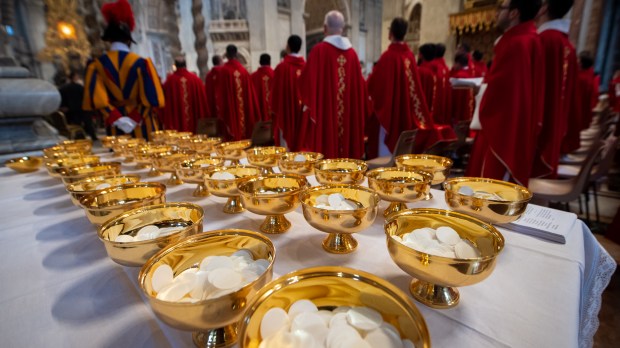“I do not intend to treat here in an exhaustive way the very rich theme of liturgical formation. I only want to offer some starting points for reflection. I think two aspects can be distinguished: formation for the Liturgy and formation by the Liturgy. The first depends upon the second which is essential.”
Pope Francis expresses this hope in an apostolic letter released June 29, 2022, the feast of Peter and Paul. The letter is a call to greater formation in liturgy and is called Desiderio desideravi, from Jesus’ words, “I have earnestly desired to eat this Passover with you.”
The Pope said that there is a lot of material for study of the Liturgy but this knowledge needs to spread “beyond the academic environment, in an accessible way, so that each one of the faithful might grow in a knowledge of the theological sense of the Liturgy.”
The document offers some of the Holy Father’s beautiful reflections on the Eucharist and the meaning of worship.
Peter and John were sent to make preparations to eat that Passover, but in actual fact, all of creation, all of history — which at last was on the verge of revealing itself as the history of salvation — was a huge preparation for that Supper. Peter and the others are present at that table, unaware and yet necessary. Necessary because every gift, to be gift, must have someone disposed to receive it.
The Pope says he is calling not for a dry mental exercise: “I repeat: it does not have to do with an abstract mental process, but with becoming Him. This is the purpose for which the Spirit is given, whose action is always and only to confect the Body of Christ. It is that way with the Eucharistic bread, and with every one of the baptized called to become always more and more that which was received as a gift in Baptism; namely, being a member of the Body of Christ. Leo the Great writes, ‘Our participation in the Body and Blood of Christ has no other end than to make us become that which we eat.'”
Symbols
At the heart of the lack of liturgical formation, the Pope suggests, is the modern inability to understand symbols.
“The task is not easy because modern man has become illiterate, no longer able to read symbols; it is almost as if their existence is not even suspected.”
He said that we see this first off in the way we treat the human body, which he calls a symbol “because it is an intimate union of soul and body; it is the visibility of the spiritual soul in the corporeal order; and in this consists human uniqueness, the specificity of the person irreducible to any other form of living being.”
Our openness to the transcendent, to God, is constitutive of us. Not to recognize this leads us inevitably not only to a not knowing of God but also to not knowing ourselves. It is enough to look at the paradoxical way in which the body is treated, in one moment cared for in an almost obsessive way, inspired by the myth of eternal youth, and in another moment reducing the body to a materiality to which there is denied every dignity. The fact is that value cannot be given to the body starting only from the body itself. Every symbol is at the same time both powerful and fragile. If it is not respected, if it is not treated for what it is, it shatters, loses its force, becomes insignificant.
The Pope referred to his namesake, St. Francis, saying we “no longer have his gaze” — “To have lost the capacity to grasp the symbolic value of the body and of every creature renders the symbolic language of the Liturgy almost inaccessible to the modern mentality.”
“And yet,” Pope Francis insists, “there can be no question of renouncing such language. It cannot be renounced because it is how the Holy Trinity chose to reach us through the flesh of the Word.
Instead, he says:
It is rather a question of recovering the capacity to use and understand the symbols of the Liturgy. We must not lose hope because this dimension in us, as I have just said, is constitutive; and despite the evils of materialism and spiritualism — both of them negations of the unity of soul and body — it is always ready to re-emerge, as is every truth.
Here the Pope offered what he called a “simple way”
I have in mind parents, or even more perhaps, grandparents, but also our pastors and catechists. Many of us learned the power of the gestures of the liturgy from them, as, for example, the sign of the cross, kneeling, the formulas of our faith. Perhaps we do not have an actual memory of such learning, but we can easily imagine the gesture of a larger hand taking the little hand of a child and accompanying it slowly in tracing across the body for the first time the sign of our salvation. Words accompany the movement, these also said slowly, almost as if wanting to take possession of every instant of the gesture, to take possession of the whole body: “In the name of the Father… and of the Son… and of the Holy Spirit…. Amen.” And then the hand of the child is left alone, and it is watched repeating it all alone, with help ready nearby if need be. But that gesture is now consigned, like a habit that will grow with Him, imparting to it a meaning that only the Spirit knows how. From that moment forward that gesture, its symbolic force, is ours, it belongs to us; or better said, we belong to it. It gives us form. We are formed by it. Not many discourses are needed here. It is not necessary to have understood everything in that gesture. What is needed is being small, both in consigning it and in receiving it. The rest is the work of the Spirit. In this way we are initiated into symbolic language. We cannot let ourselves be robbed of such richness. Growing up we will have more ways of being able to understand, but always on the condition of remaining little ones.


